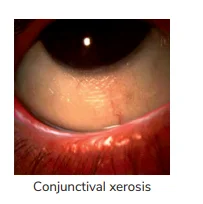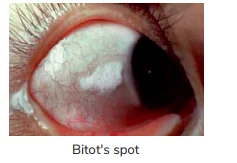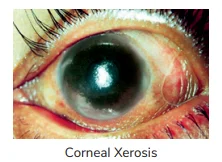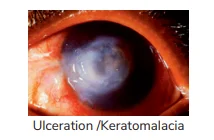Xerophthalmia: Causes, Symptoms, Grading and Risk Factors
Aug 1, 2023
Navigate Quickly
Causes Of Xeropthalmia
Symptoms Of Xeropthalmia
WHO Grading of Xerophthalmia
Night Blindness (XN)
Conjunctival Xerosis (X1A)
Bitot's Spot (X1B)
Corneal Xerosis(X2)
Ulceration /Keratomalacia (3 A, B)
Corneal Scars (XS)
What Are The Sources Of Vitamin A?
Risk Factors Of Xerophthalmia
Diagnosis Of Xeropthalmia
Treatment Of Xeropthalmia
Is It Possible To Prevent Xeropthalmia?

A lack of vitamin A can lead to a degenerative eye condition known as xerophthalmia. Your tear ducts and eyes may get dry if you don't get enough vitamin A. Xerophthalmia can progress into night blindness or more severe damage to your cornea, the outer layer of your eye. White patches on your eyes and corneal ulcers are two signs of this injury. With vitamin A therapy, xerophthalmia may typically be reversed.

Causes Of Xeropthalmia
Lack of vitamin A is the root cause of xerophthalmia. Vitamin A cannot be produced by your body on its own. Instead, you must consume meals to obtain vitamin A. Because it is a component of the protein that absorbs light in the receptors in your retina, vitamin A is crucial for vision.
The health and maintenance of your heart, lungs, kidneys, and other organs depend on vitamin A.
In the United States, the United Kingdom, and other industrialized nations, xerophthalmia is uncommon. However, it is still prevalent in developing nations where people could have little access to animal products.
Also Read: Ocular Rosacea: Causes, Symptoms, Diagnosis, Treatment and Complications
Symptoms Of Xeropthalmia
Xerophthalmia symptoms can progress from mild to severe if a vitamin A deficiency is left untreated. When you have this condition, the conjunctiva, the thin covering that borders your eyelid and eyeball, dries up, thickens, and wrinkles. That drying out and wrinkles result in various symptoms.
Blindness at night is a primary indicator. It is difficult to see in low light because of this. The World Health Organisation and public health specialists have used night blindness prevalence as a stand-in for vitamin A deficiency in a population.
As xerophthalmia progresses, lesions form on your cornea. These tissue aggregations are known as Bitot's spots. Additionally conceivable are corneal ulcers. When the sickness is most advanced, some or all of the cornea gets liquified which eventually leads to blindness.
Also Read: Melanoma Of Eye: Causes, Symptoms, Risk Factors, Diagnosis, Treatment And Complications

WHO Grading of Xerophthalmia
The grading helps determine the severity of the condition. The signs are denoted by X and a subscript. They are:
- Xn → night blindness nyctalopia: the earliest sign
- X1a → conjunctival xerosis
- X1b → bitots spot
- X2 → Corneal xerosis
- X3a → keratomalacia in less than one-third of the cornea
- X3b → keratomalacia in more than one-third of the cornea (keratomalacia is liquefactive necrosis of cornea)
- Xs → cornea scarring
- Xf → xerophthalmia fundus. white spotted fundus and decreased amplitude in electroretinogram
Night Blindness (XN)
- Earliest clinical manifestation of VAD
- Also called “chicken eyes” as chickens don't have rods, are night blind
- Early stages are precipitated by photic stress like playing outdoors in bright sunlight
- Night blindness responds rapidly to Vitamin A therapy, within 24-48 hours
Conjunctival Xerosis (X1A)

- The epithelium is transformed from normal columnar to stratified squamous epithelium with loss of goblet cell and keratinization
- Expressed as marked dryness or unwettability and appears roughened · “sandbanks after receding tides”
- Starts first in the temporal quadrant
Bitot's Spot (X1B)

- Characteristic of VAD, not caused by any other condition.
- Elevated foamy white lesion of keratin
Corneal Xerosis(X2)

- Begins with superficial punctate lesions in the inferior nasal quadrant of cornea
- Cornea becomes hazy and lustreless, starting from the inferior limbus
Ulceration /Keratomalacia (3 A, B)

- Liquefactive Necrosis of corneal stroma
- Ulcers are typically round or oval 'punched–out' defects surrounding the clear cornea, with no infiltration as in bacterial ulcers
- Shallow ulcers heal well with vitamin A therapy, deep ulcers perforate and lead to adherent leucoma
- 3B keratomalacia usually perforates, with loss of globe
- Prompt therapy may save other eyes
Corneal Scars (XS)

Corneal opacities of all kinds like Nebula, macula, leucoma, adherent leucoma
This may lead to staphyloma which is:
- Thinning and outpouching of sclera with iris incarceration
- Descemetocele
- Phthisis bulbi
Also Read : Allergic Conjunctivitis
What Are The Sources Of Vitamin A?
Retinol is another name for vitamin A. It's a fat-soluble chemical that can be found in things like:
- Fish liver
- Poultry
- Meat
- Dairy ingredients
- Eggs
In the form of beta carotenes, vitamin A can also be obtained from vegetables. In your intestines, beta carotenes are transformed into retinol. However, compared to consuming animal products as a source of vitamin A, this approach is ineffective. Beta carotenes can be found in:
- Leafy green vegetables
- Fruits and veggies
- Black palm oil
Also Read: Eye Strain: Causes, Symptoms, Risk Factors, Diagnosis, Treatment and Complications
Risk Factors Of Xerophthalmia
The main causes of xerophthalmia are poverty and an inadequate diet, particularly one that excludes animal products. Children and infants are more vulnerable. The effects of vitamin A deficiency are particularly severe in young children.
Vitamin A is essential for children's growth. The ability to resist common pediatric illnesses and infections like diarrhea, measles, and respiratory infections is also impacted by vitamin A deficiency.
In the United States and other nations, a considerably smaller population is impacted by additional risk factors. Because they interfere with a person's ability to absorb vitamin A, the following are risk factors:
- Alcoholism
- Cystic fibrosis
- Conditions that prevent nutrients from being absorbed, such as celiac disease and liver cirrhosis
- Chronic diarrhea
- Radioiodine therapy for Thyroid cancer that can show symptoms of xerophthalmia.
Also Read: Iritis: Causes, Symptoms, Risk Factors, Diagnosis, Treatment and Complications
Diagnosis Of Xeropthalmia
People must consult their doctor if they experience overt symptoms like dry eyes. The doctor might look at the symptoms and past while performing a physical examination. They might assess their diet as well.
To assess the body's vitamin A levels, the doctor may also request a blood test. The doctor can start treating patients who have severe xerophthalmia or night blindness right once.
Treatment Of Xeropthalmia
In regions where xerophthalmia is recognized as a concern, vitamin A supplements are used as a preventative measure. This is a cheap technique to stop suffering and fatalities among people. 500 million vitamin A capsules are provided annually, according to a 2007 studyTrusted Source, for an affordable price of 10 cents each.
Making the most of one's food resources can be aided through nutrition education. Vitamin A enrichment in processed foods aids in lowering vitamin A deficiency. Listed below are a few examples of fortified foods:
- Fats and oils
- Grains
- Milk
- Sugar
- Golden rice, which has beta carotene added through genetic engineering, is another potential source of vitamin A. Groups opposed to food that has undergone genetic alteration have opposed it.
Also Read: Fuchs' Dystrophy: Causes, Symptoms, Risk Factors, Diagnosis and Treatment
Is It Possible To Prevent Xeropthalmia?
Vitamin A supplements can be taken in order to prevent xerophthalmia. The prevention of this condition may also be aided by increasing the intake of vitamin A in the diet. The following are some foods that are high in vitamin A and are simple to include in the diet:
- Fish oil
- Liver
- Chicken
- Eggs
- Carrots
- Lemons
- Mangoes
- Milk or dairy products
- A leafy vegetable
- Vitamin A-rich foods can help prevent xerophthalmia and support general health by being incorporated into the diet.
Download the PrepLadder App and get the best neet pg online coaching with world-class video lectures, QBank, Mock Tests and more!
Download PrepLadder's best app for neet pg preparation for Android
Download PrepLadder's best app for neet pg preparation for ios

PrepLadder Medical
Get access to all the essential resources required to ace your medical exam Preparation. Stay updated with the latest news and developments in the medical exam, improve your Medical Exam preparation, and turn your dreams into a reality!
Top searching words
The most popular search terms used by aspirants
- NEET PG Ophthalmology
- Ophthalmology Medical PG
PrepLadder Version X for NEET PG
Avail 24-Hr Free Trial